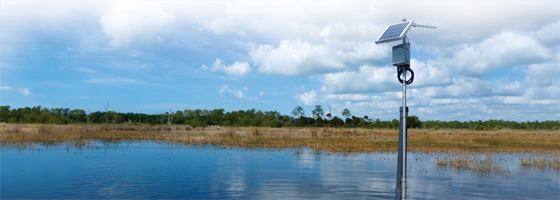Wireless wetland: data supports Everglades restoration

On a muggy day in January, 2012, researchers waded into the south Florida wetlands to install a monitoring tower. Located near Big Cypress Swamp, the equipment will take hourly measurements and report back on the water quality of the wetlands.
The long-term goal is to help restore the area, according to project’s leader, Dr. Li Zhang, assistant director of the Everglades Wetland Research Park. First, they need to know the baseline conditions — hence the wading trip.
“We need scientific data to support [restoration efforts],” she explains.
The Everglades Wetland Research Park is part of the Kapnick Center, located on the campus of the Naples Botanical Garden. The research park, which is a Florida Gulf Coast University facility, was created to “provide teaching, research, and service related to wetland, river, and coastal science and ecological engineering.”
South Florida’s ecosystem needs all the help it can get. Unaware of the hugely important niche occupied by wetlands, successive generations attempted to drain and control the area. In 1948, Congress authorized the Central & Southern Florida Project (CSF), an ambitious and mostly successful effort to tame and control the floodwaters that continually ravaged South Florida. About 1,000 miles of levees, 720 miles of canals, and nearly 200 miles of water control structures were built to “provide water supply for municipal, industrial, and agricultural uses, prevention of saltwater intrusion, water supply for Everglades National Park, and protection of fish and wildlife resources,” according to the Comprehensive Everglades Restoration Plan.
The CSF was passed in response to decades of difficulties with the South Florida landscape. The area’s interior was barely habitable. Droughts threatened the fresh water supply and floods destroyed homes. Unfortunately, while the CSF fueled South Florida’s development, it worsened the Everglades’ serious problems.
While the ecosystem used to be the domain of alligators, panthers and countless flocks of migratory birds, the wildlife dwindled as the human population rose from 500,000 in the 1900s to its current level of 6 million. The term “Everglades” generally is shorthand for Everglades National Park, but the “River of Grass” used to cover nearly all of South Florida. The whole ecosystem of the area has been impacted by development.
Now (as before), the area suffers from droughts and overabundance of water, usually at the wrong times of the year. Development caused water to run off too quickly, draining into the ocean and reducing the water available to the ecosystem. What water did enter was of poor quality, and it no longer moved freely throughout the system.
Over the past decades, the world has come to appreciate the beneficial role that wetlands play in the larger ecosystem. The Ramsar Convention on Wetlands lists flood control, groundwater replenishment, shore stabilization and storm protection, water purification, and climate change mitigation and adaptation among the benefits of wetlands — the same benefits that draining was supposed to provide. The convention classifies the Everglades as a “Wetland of International Importance,” in addition to its designations as a World Heritage Site and International Biosphere Reserve.
The Water Resources Development Acts of 1992 and 1995 started a process of reexamining the CSF, and the creation of an ambitious long-term initiative – the Comprehensive Everglades Restoration Plan – to renew the health of the ecosystem. One of the goals of the plan is to capture most of the 1.7 billion gallons of water that are discharged daily and use it to supply the natural system and the needs of the population. More than 240 miles of project canals and internal levees will be removed to lift barriers to water movement.
Long marginalized, the Everglades are finally being appreciated, but Zhang’s research won’t stop at the South Florida border. The restoration project has larger goals than local development. Collaboration with international scholars is planned, as well as inquiry into how wetlands can help mitigate the effects of climate change.
“Wetlands are a very important landscape,” Zhang says.





0 comments